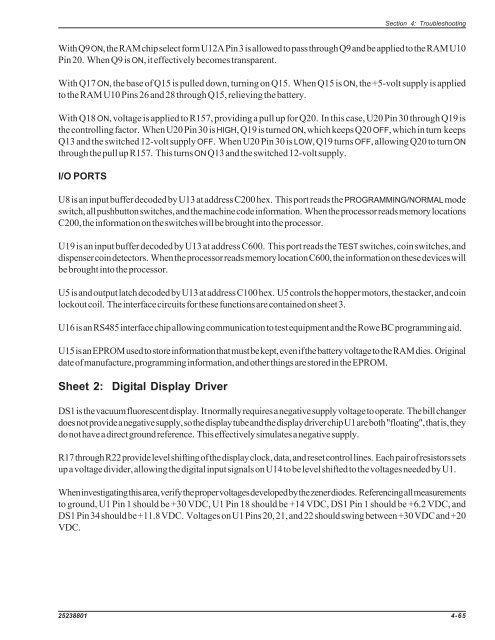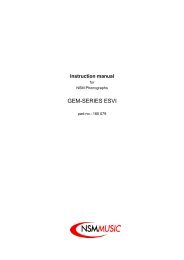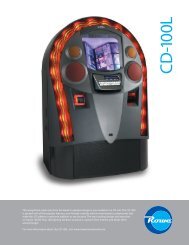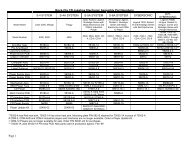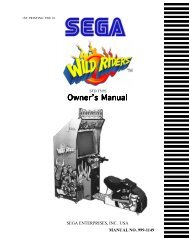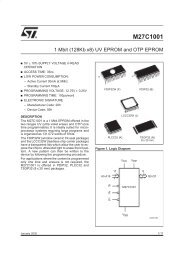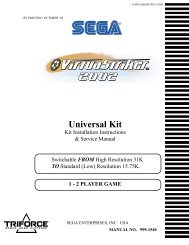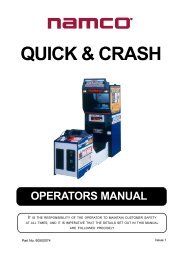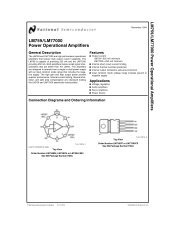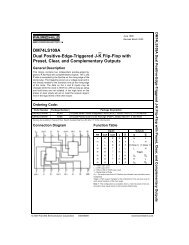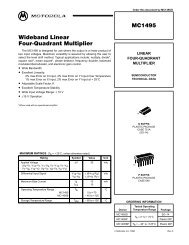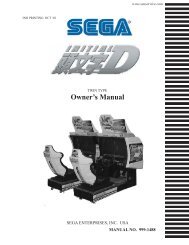BC-3500 Series - Rowe International
BC-3500 Series - Rowe International
BC-3500 Series - Rowe International
Create successful ePaper yourself
Turn your PDF publications into a flip-book with our unique Google optimized e-Paper software.
Section 4: Troubleshooting<br />
With Q9 ON, the RAM chip select form U12A Pin 3 is allowed to pass through Q9 and be applied to the RAM U10<br />
Pin 20. When Q9 is ON, it effectively becomes transparent.<br />
With Q17 ON, the base of Q15 is pulled down, turning on Q15. When Q15 is ON, the +5-volt supply is applied<br />
to the RAM U10 Pins 26 and 28 through Q15, relieving the battery.<br />
With Q18 ON, voltage is applied to R157, providing a pull up for Q20. In this case, U20 Pin 30 through Q19 is<br />
the controlling factor. When U20 Pin 30 is HIGH, Q19 is turned ON, which keeps Q20 OFF, which in turn keeps<br />
Q13 and the switched 12-volt supply OFF. When U20 Pin 30 is LOW, Q19 turns OFF, allowing Q20 to turn ON<br />
through the pull up R157. This turns ON Q13 and the switched 12-volt supply.<br />
I/O PORTS<br />
U8 is an input buffer decoded by U13 at address C200 hex. This port reads the PROGRAMMING/NORMAL mode<br />
switch, all pushbutton switches, and the machine code information. When the processor reads memory locations<br />
C200, the information on the switches will be brought into the processor.<br />
U19 is an input buffer decoded by U13 at address C600. This port reads the TEST switches, coin switches, and<br />
dispenser coin detectors. When the processor reads memory location C600, the information on these devices will<br />
be brought into the processor.<br />
U5 is and output latch decoded by U13 at address C100 hex. U5 controls the hopper motors, the stacker, and coin<br />
lockout coil. The interface circuits for these functions are contained on sheet 3.<br />
U16 is an RS485 interface chip allowing communication to test equipment and the <strong>Rowe</strong> <strong>BC</strong> programming aid.<br />
U15 is an EPROM used to store information that must be kept, even if the battery voltage to the RAM dies. Original<br />
date of manufacture, programming information, and other things are stored in the EPROM.<br />
Sheet 2: Digital Display Driver<br />
DS1 is the vacuum fluorescent display. It normally requires a negative supply voltage to operate. The bill changer<br />
does not provide a negative supply, so the display tube and the display driver chip U1 are both "floating", that is, they<br />
do not have a direct ground reference. This effectively simulates a negative supply.<br />
R17 through R22 provide level shifting of the display clock, data, and reset control lines. Each pair of resistors sets<br />
up a voltage divider, allowing the digital input signals on U14 to be level shifted to the voltages needed by U1.<br />
When investigating this area, verify the proper voltages developed by the zener diodes. Referencing all measurements<br />
to ground, U1 Pin 1 should be +30 VDC, U1 Pin 18 should be +14 VDC, DS1 Pin 1 should be +6.2 VDC, and<br />
DS1 Pin 34 should be +11.8 VDC. Voltages on U1 Pins 20, 21, and 22 should swing between +30 VDC and +20<br />
VDC.<br />
25238801 4-65


